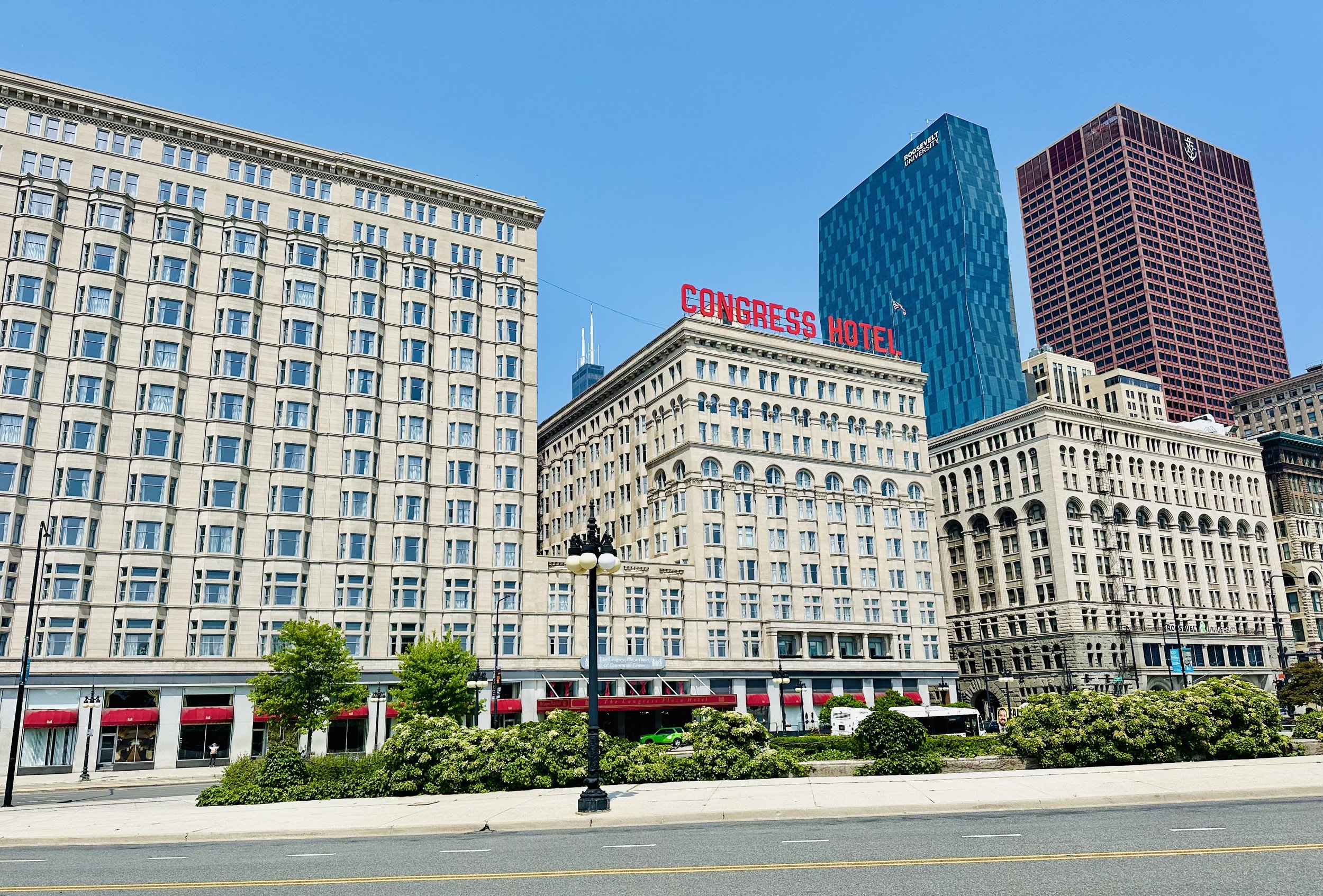Grant Park
Stretching east of Michigan Avenue to the shores of Lake Michigan, Grant Park is Chicago’s “Front Yard” and a jewel of the city. We have visited Millennium Park and the Art Institute of Chicago many times, but they comprise just one small corner of Grant Park. So on a warm, sunny morning, we took a walking tour hosted by the Chicago Architecture Center called Grant Park Secrets.
Our docent, John, was a spry fellow with a sonorous voice. The “secrets” were really fun facts, and he had plenty of them to share. He started with a brief history of Grant Park, which is as old as the city of Chicago (1837). It was initially just a narrow strip of land along Lake Michigan, set aside for public use. So nearly all of Grant Park was once in the lake! A railroad viaduct was built along the shoreline in the 1850s, and debris from the Great Chicago Fire was dumped there in 1871. Through the years, the park grew larger in stages, with landfill (er, lakefill) from tunnels and other construction projects. The landscape design was by Edward Bennett, an American architect who had trained in Paris at the École de Beaux-Arts.
Walking south from the Art Institute along Michigan Avenue, we enjoyed the manicured gardens and public art.
The Art Nouveau entrance to the Van Buren Metra station was cast from the same molds used for the Paris Metro, designed by Hector Guimard. (It is scheduled for removal because it doesn’t comply with accessibility requirements.)
The muscled bronze equestrian statues, known as Bowman and Spearman, were created by Croatian sculptor Ivan Meštrović. They flanked the park’s original main entrance at Congress Plaza, where there was once a grand staircase. The bow and spear are missing, but they weren't removed or stolen - the artist wanted viewers to focus on other elements.
The Spirit of Music, a bronze statue of an imaginary muse, was in honor of Theodore Thomas, the founder and first conductor of the Chicago Symphony Orchestra.




There were also many interesting buildings on the other side of Michigan Avenue. For example:
Three Beaux-Arts buildings in a row were designed by different architects and built at different times, yet blended harmoniously: the Auditorium Building (Adler & Sullivan, 1889), the Congress Hotel North Tower (Clinton Warren, 1893), and the Congress Hotel South Tower (Holabird & Roche, 1907).
On an avenue lined with historic buildings of brick and stone, the Spertus Institute (Krueck + Sexton, 2007) stood out with modern flair. The distinctive origami-like façade was made from 726 individual glass panels in 526 different shapes.
The Hilton Chicago was the largest hotel in the world when it opened as the Stevens Hotel in 1927. This massive building with three brick towers boasted 3,000 guest rooms, a 1,200-seat movie theater, a 27-chair barbershop, a five-lane bowling alley, and an 18-hole golf course! Hilton acquired it in 1946. Several movies were filmed here, including The Fugitive (1993) with Harrison Ford and Tommy Lee Jones.



We continued south along Michigan Avenue, where there were still more gardens and art.
The John Alexander Logan Monument was at the top of a grassy hill, with panoramic views of Chicago’s skyscrapers. Logan was an Illinois hero, a Union army general and congressman, and the first to declare Memorial Day a national holiday. The hill was built as a tomb for Logan and his wife, but they were buried in Washington, D.C. instead.
A small bust and garden honored Aaron Montgomery Ward, who invented mail-order retail in 1872. Ward is the reason Grant Park exists today. As a Michigan Avenue property owner, Ward had a say in what structures were built on the lakefront. He believed that Grant Park should be “forever open, clear, and free” to all. Ward sued the City of Chicago repeatedly to preserve the park, finally prevailing after a twenty-year legal battle.
At the southwest corner of Grant Park was an unusual art installation called Agora, consisting of 106 headless figures, each one nine feet tall and weighing 1,800 pounds! The figures seem human, though they are headless, and they appear to be walking in different directions. Like other Chicago public sculpture (such as the Picasso), it’s a polarizing work of art.





At 11th Street, we walked east, toward Lake Michigan. Soldier Field (1924), home of the Chicago Bears, was visible in the distance. Our guide explained that the road leading to Soldier Field was privately owned, and used only for shuttling fans to and from football games. Then we walked north up the center of Grant Park, along Hutchinson Field, named after the founder of the Art Institute. This huge open space filled with softball fields was cleverly set at a lower elevation, to reduce traffic noise. This was where President Barack Obama delivered his victory speech on Election Night 2008, and the site of the annual Lollapalooza music festival.


The Tiffany Celebration Garden was beautifully manicured, a popular site for wedding receptions. It made a beautiful frame for the Buckingham Fountain in the distance. After the Tiffany Garden were two bronze statues surrounded by blooming roses, Turtle Boy and Dove Girl.
We arrived at the iconic Buckingham Fountain, with its backdrop of skyscrapers, just in time to catch the last five minutes of the hourly water show. At the center of the fountain, water was spouting 150 feet into the air! It was quite impressive, and we hope to return at night to see the water show with lights. This was the end of our tour, and a grand finale to our walk through Grant Park.



